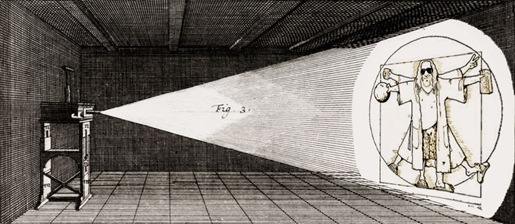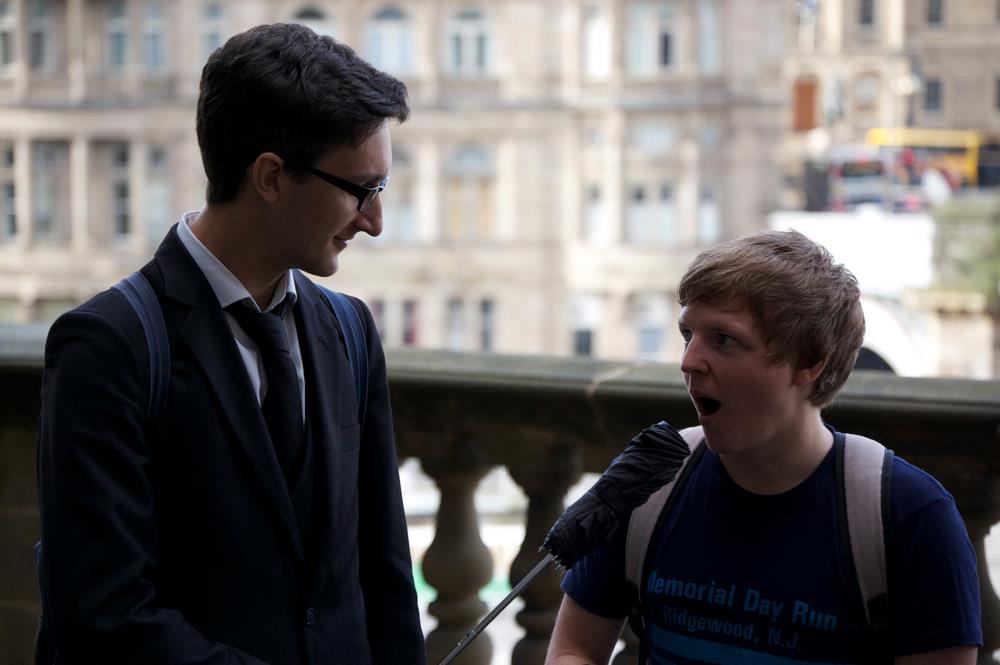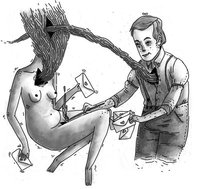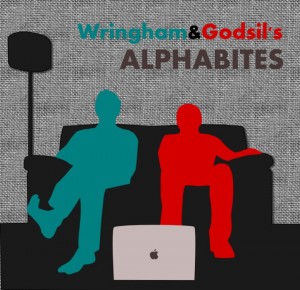Paul Bourgault is a visual artist in Montreal. He usually works in collage and paints. Among his most recurring themes are those of Catholic and Renaissance iconography, and he often uses vibrant colour and sensuous imagery on his large canvases.
It is a privilege to visit Paul’s studio. Seven months previously, I’d been present at the opening of his exhibition Grande Consecration des Utopies Approximatives at Montreal’s Maison de la culture Frontenac and I’d seen a further collection of his works at the Toronto International Art Fair. On both occasions, his work had struck a chord with me, perhaps because of its imposing presence but perhaps because it reminds me of the closest thing I’ve ever had to a spiritual experience, absorbed in the splendor of Renaissance art in Vatican City. I have a lot of respect for the works of Paul Bourgault and so being in his studio and paying witness to so many works in progress is both an honor and disconcerting. The dozen or so canvases propped up around the room are incomplete but each is unmistakably a Bourgault. Seeing them, I think, is like bearing witness to half-formed stars in the depths of a nebula.
The studio is a small space on the upper floor of a tall building. There’s a city law preventing architecture from exceeding the height of Mount Royal, so the view from Paul’s window is a rare opportunity. The island’s snow-covered east side stretches out before us: the domes and spires of Mile End and Roger Tallibert’s organic-modernist Olympic Stadium on the horizon. A wall of Paul’s studio displays a quote from a motivational speaker called Les Brown: “Shoot for the moon. Even if you miss, you’ll land among the stars”. I suspect this was left behind by the studio’s previous occupant. Paul doesn’t strike me as aggressively ambitious: the act of creation is the important thing to Bourgault.
Paul welcomes me into the studio. After a tour of the canvases closest to completion (and one wholly incomplete, untitled piece that marks his pending transition from mixed media to pure painting), we crack open a couple of beers and our conversation begins.
I understand you were originally trained in film. Was it a challenging transition to go from film to painting?
When I started college in the mid-eighties, the art scene in Montreal—at least the art scene I knew—was not very open to certain types of painting or draftsmanship. It was more conceptual and installation[-driven]. I’m not saying it was the right decision, but it doesn’t take much when you’re young to intimidate you. Maybe I would go into studying art if I were to do it all over again but, you know, that’s impossible. I loved film but I was always more of a draftsman or a painter than a film expert or a film maker, so film was like an escape route. Also, I had very little interest in school, so film was interesting. It was one of those decisions of picking something that you’d like to do instead of making a smart decision with a specific goal.
Film brought me into working in sets. I was a scenic artist; a set painter in film, opera sets, television and television advertising. One thing I learned here was how to be efficient. When I do my own paintings—like any artist—a lot of my emotions and my vision of the world goes into it. When you’re a set painter, you’re almost like a painting machine, so while you have to reflect on the task, you don’t have to reflect on whatever the film maker is trying to convey. You only see pieces of it. You’re told ‘paint this barn’. You’re stuck with how to do it so there’s a lot of problem solving but you’re not asked to make decisions per se. So that was extremely useful. I did that for about ten or fifteen years at least.
So film gave you a kind of work ethic.
Yes! If you go on a film set, we agree that film is a true art form. As is painting, architecture, dance: there’s no doubt about it – that film is a true art form. Of course, there’s a lot of preparation that goes into it, but when the film crew is working, no one stops to look at their belly button. This is costing us ten-thousand dollars a minute, guys, let’s go! So I did learn that. I’m not always as good as I should be or as disciplined, but I do have a strong work ethic. I think that film might have given me the attitude that you can be a creator and be on the ball. Creating doesn’t mean sitting down and waiting for stuff to happen.
To what extent is your work autobiography? Do you bring much from your heritage or your family background or your own emotional landscape?
It’s mostly autobiographical. Mostly in an emotional, spiritual and philosophical way. I’m quite sure that we have old memories stored into us. I don’t know how it works. I’m not a neurosurgeon or an expert but my gut feeling is that we have some sort of very long-term memories stored away somewhere in our brains: cultural memories. Because we’re all mixed, it comes from everywhere. Most of my heritage is French, but the French were conquered by the Norsemen by the Germanic tribes and so on.
And we all go back to Africa ultimately.
Yeah, that’s it. I do believe that. Another thing is being here in Québec where the Catholic religion had quite a strong presence. My mother was probably of the first generation, as an adult, to get rid of it as an overbearing presence. I don’t think that the church in itself is that awful but I think there is a problem when it’s overbearing. There’s a lot of reference to Renaissance painting in my work. I think the main reason is that I simply love those paintings and the work that went into making them, but also there’s a link in there to the Catholic church in Québec. So there’s this dual interest. Some of those [Renaissance] paintings are just so stunning. They still shock me when I go to museums. To complement your question, I think all of my paintings are to a large extent autobiographical. I don’t know that it shows or that it should show, but they’re all based on ideas or doubts or fears or experiences or points of view that are personal. Why is there so much information flying all over my paintings? Our minds are always at work, always stimulating and being stimulated, buzzing. Life never stops, the atoms and the planets turn. Physics and mathematics were one of the few things I liked at school. We don’t think about it because it would be burdensome to do so, but right now there are five billion people thinking, moving, talking, fighting, being born, dying. The cosmos is spinning in every which direction. Everything is in constant motion. I like that idea, that everything is alive, that there’s a force in everything and that it’s always moving.
Something I get from some of your paintings is this idea about excess and abstinence simultaneously. I’m thinking of your exhibition, ‘Carnival at Lent’ specifically.
One thing that Chinese painting has taught me is that the empty space in a painting is just as important as the rest of it. When Chinese painters do their work, they look at the lines [but also] the space between the lines. Life is all about oppositions. In that sense, my work [contains] what I believe about life. You live, you die, there’s space between things and there are oppositions between desires, like carnival and lent. What would be one without the other? If you’re doing carnival three-hundred-and-sixty-five days a year, it would lose its meaning. Getting pissed and dancing all night would become just a normal day. I don’t think it would be interesting or possible to do it six hundred days in a row.
So the whole universe is vibrating with opposites.
Yes, absolutely. And that’s an important part of what motivates my work; the idea of—the way your phrased it—that vibration, the emptiness. The universe is kind of participating in my creation. It applies to everyone but I think some people are more conscious of it or have accepted it.
You are bilingual and spent a long time in Ontario as well as Québec. I don’t know, but I imagine, there might be Francophone and Anglophone cultures of art in Québec. Is that true? And if it is true, do you feel that you exist between them or that you have one foot in both worlds or do you feel like a true third thing?
To a certain extent, every artist is out of it [and] working on his own. As far as the language goes, because it’s a super-touchy question, I’m going to answer like a politician. But real seriously, with globalisation and the Internet, we’re all connected. You can see in real-time, the paintings at an opening in Saigon. I’m not saying there are no differences but there are so many crossover practices now. If there’s a difference between a French scene and an English scene, it might be more in relation to human friendship. If you go to an English school, you have those friends and most of those friends will speak English. I’m not sure that it affects the art. We’re all mixed. It’s not like there’s a big wall between us with the French world here and the English world there. I think it’s more of a social networking difference more than an art difference.
I’m not a big part of any crowd. I mean, I go to openings and I have artist friends but I’m not really into some specific theme. It’s not, like, a scene.
Do you have any thoughts about government funding of the arts? It’s obviously good in that arts have to happen and we shouldn’t be starving as artists, but also, do you feel there’s a problem with being sanctioned?
Out of principle, I think that financing for the arts is a very good thing. We live in a social democracy and taxes should be invested in a general manner. Of course, education and health is Number One, but we all pay taxes and I think its good that artists can get a little pat on the back. Receiving a grant is good for you because it gives you time to work, time to stop worrying for a few months. It gives you a form of recognition, which is great, but making art is like a quest; you should never wait for someone to sanction you as an important motivation. I apply for grants and I think it’s smart to do so, but what wakes me up in the morning and what brings me [to the studio] every day has nothing to do with being sanctioned.
Tell me a little about your ‘Chasse-démons’ painting. It’s a personal favourite.
It’s a talisman. Everyone has demons: personal hurts and broken parts from adapting to society, from childhood, from disappointments we have about life. We all have some open scars. Maybe some people are more sensitive about these, so I had this idea of painting something that could help you chase away these demons. But I also painted it for myself. I figured maybe some day a man or a woman could say ‘yeah, I could use one of those talismans’.
I was reading a lot about the Bohemians recently. About Nineteenth Century Bohemians. They’d often keep a skull around the place, and it was like a talisman against becoming bourgeois. It’s like a constant reminder of death, that one day you’re going to be a skull in the Earth.
That’s very interesting. It’s a Memento-Mori. I collect art a bit. I only have small works, but usually, the work that I buy are Memento-Mori. For me, and this is strictly personal, art has to do important things for you. There’s no reason it can’t be beautiful but if all art were beautiful it would be useless. In my own work, there are often little details of skulls, bones, trash and stuff that looks like dead animals, and there are dead birds. I don’t want anyone to be ‘oh wow, dead birds’ because I like my work to be beautiful, colourful, sensuous, vibrant, but I like that in almost every piece there’s a little Memento-Mori: just a little something to remind you that you’re passing through. You’re just passing through. I think that life is beautiful. To have a little reminder of death is very important but only if you enjoy life. Dancing is great, food is great, sex is great, friendships are great, the sunset is beautiful. I enjoy life, but as you were saying about the Bohemians, to always keep a little something, like a little wink that says ‘don’t forget’.
Well, it’s what encourages you to live vigorously. Knowing that this is it.
Yeah! And it’s like the opposites of the universe, as we were saying earlier on. If we had eternal life and we know it, boy, we’d be fucking bored. We’d only be playing cards or something like that, you know.
Are there other artists whose work you draw from?
Many. And I’ve noticed as the years go by that I’m more and more open-minded. I was not as open-minded when I was a young adult. Of course there are many strong influences, like painters of the Renaissance, Rubens, Rembrandt , the use of colour in Vincent van Gogh’s work has inspired me a lot. Colour has a hell of a lot of importance in my work. For me, colour is like an emotion, it’s like energy, it’s like life. I don’t mean ‘red is this, yellow is that’, but the interaction of colour is a really magical aspect of painting.
But yes, Rembrandt especially. I’m not nostalgic, but I like old painting because it’s kind of out of time. I like to think that my work might also be somewhat out of time. I mean, you can’t truly become out of one’s own time, but I like not to voluntarily push it into it. You know what I mean by that? This might be a bad example, but I use a computer and I find lots of things about it useful so I’m living in my time. But I’ve never had a Twitter account and I never will have Facebook. It’s going too far. I can understand why some people want to use those tools, but for me, I like to keep a safe distance. You can tell that my paintings are being painted ‘now’, but I like to think they are happening out of time a bit as well. The references are hopefully a little timeless.
As a self-taught painter, I learnt what I know about art history and art by reading and going to museums. I go to the library a lot. When you’ve absorbed so much information, you’re in a sense influenced by all of that. You have favourites but it all just becomes part of you over time.
I saw a documentary recently at the [Musée des beaux-arts de Montréal] about Warhol’s protegee, Jean-Michel Basquiat and, in it, he said a lovely thing. He was asked how he is influenced by other people and he said “it’s someone else’s idea going through my new mind”. Going through my new mind. Isn’t that perfect?
Painters have always had affiliation: ideas that are inherited from father to son. If you look at the history of art, I think everything has been done through affiliation because every artist is inspired by and inspires his contemporaries and his friends. The Basquiat thing is very interesting and true because painters nourish other painters. You look at Bosch and Picasso and you mix and match and something weird comes out and you sprinkle something else onto it. I’m inspired by many, many painters so it’s hard to pinpoint now.
[One of your art dealers] told me that you now want to do more painting without using collage?
It’s a shift. Every work leads you to another work, like communicating vessels. Sometimes you make drastic decisions but generally you carry stuff with you. You bring maybe ninety percent of the last work into the new work. I’m trying to paint myself out of collage and I’m finding it a gradual process. A thing about art is that I have to avoid being comfortable. If I’m too comfortable and safe in what I’m doing, it doesn’t stimulate me. You can’t cut all the bridges: you can’t one day say ‘I’ll never paint like this again’ and paint like someone else. You can’t run away from yourself. A singer doesn’t change his voice in five minutes. It is done over years. But collage helped me feel a certain danger, a certain risk, to do things I wasn’t comfortable with. But now it’s turning into a comfort zone. I’m starting, with painting, to get myself out of that zone.
*
We talk for another hour or two about work ethics, stand-up comedy, long-distance walking, Canada, physics and space, while the unfinished pieces around us – the embryonic stars in the nebula – vibrate with potential energy. Paul Bourgault’s channeling of primal, atomic, and universal forces is the very reason for these paintings’ existing ‘out of time’. While human beings may benefit from a Memento Mori, these ideas remain eternally untouched by the currents of time.

 I’m researching a book about Simon Munnery’s Cluub Zarathustra (1993-1997).
I’m researching a book about Simon Munnery’s Cluub Zarathustra (1993-1997). On 10th October 2011, I’ll take part in
On 10th October 2011, I’ll take part in 







 Our rambling, shambling, deliciously-dangling podcast makes a triumphant return with
Our rambling, shambling, deliciously-dangling podcast makes a triumphant return with 
